
Although several independent schools for African Americans were established during the Reconstruction period, publicly funded schools for these students did not open until the early 1880s. In Galveston’s east end, African American children attended the East District School located on Broadway between 9th and 10th streets. Grades first through seventh were taught at the single campus.
Izola Collins describes how the first schools for African Americans were established in Galveston. Her grandfather, Ralph Scull, became the first Galveston-born educator to teach at these schools.

When the Great Storm of September 8, 1900 struck Galveston Island, the East District School — a frame building — was completely destroyed.
In the Fall of 1901, a house at 13th and Avenue M 1/2 was rented to conduct East District classes until a new four-room schoolhouse was built.
Listen to Izola Collins talk about her first day attending kindergarten at the East District School in the 1930s.

A larger school was built at 25th Street and Avenue I followed by a parish church, also called Holy Rosary, to serve Galveston’s black Catholic community. The school operated for 93 years until closing in 1979.
Irenaeus Jordan fondly recalls the nuns who taught at Holy Rosary School.
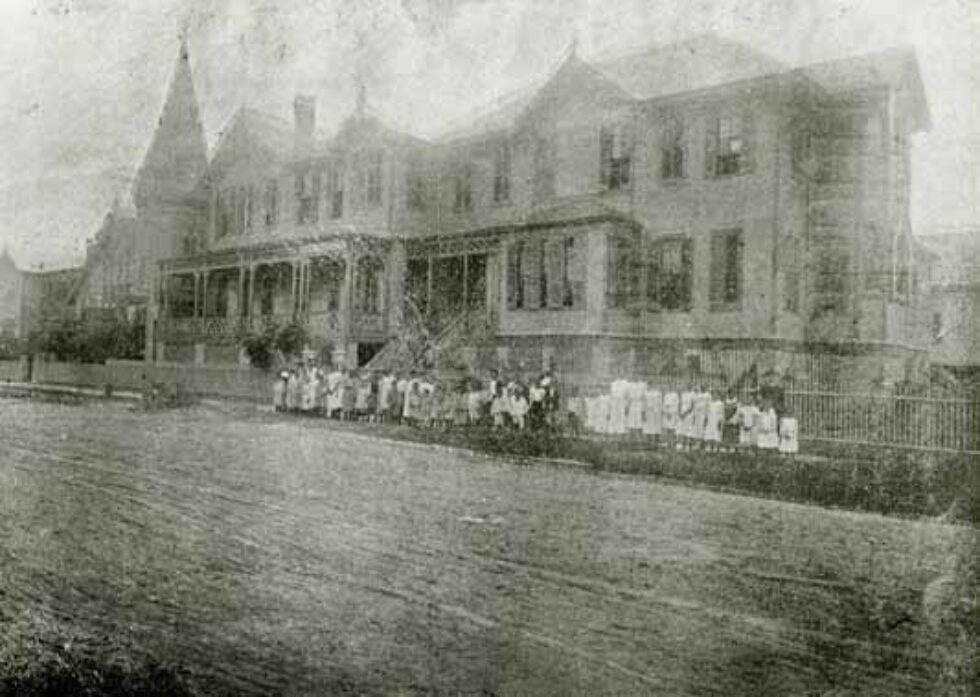
Established in 1889, Holy Rosary Church was the first church dedicated to serving African American Catholics in the state of Texas. Initially located on Avenue L and 25th Street, Holy Rosary Church moved to Avenue N and 31st Street in 1914. A new church was built on the site in 1958, and today it continues to operate as part of Holy Family Parish of Galveston and Bolivar.
Irenaeus Jordan explains the close relationship between families, the school, and the church at the Holy Rosary campus.
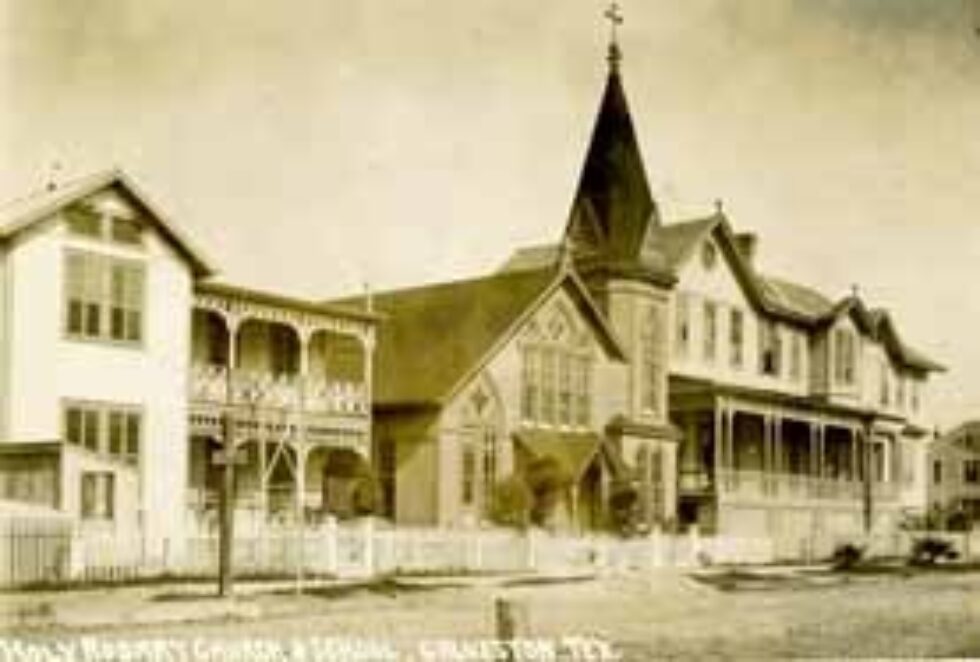
This photo shows the grand 1890 John Sealy Hospital with the smaller frame “Negro Hospital” to the rear. The Negro Hospital lacked basic amenities provided to white patients in the main building. To address these inequities, a group of black women formed the Colored Women’s Hospital Aid Society to raise funds for the purchase of new hospital beds, wheelchairs, patient gowns, and infant cribs, among other projects.
The Negro Hospital closed in 1953 after the construction of a new John Sealy Hospital which included a segregated wing. During the 1960s, John Sealy Hospital eliminated this practice and all hospital facilities became fully integrated.
Frederick Ferguson recalls the treatment for rickets prescribed to him as a young child.
Alice Gatson remembers a traumatic childhood accident which caused her sister to be hospitalized.

John Clouser, a local educator, created the Volunteer Health League in the 1930s. The goal of this group was to educate the African American community about best health practices. Each year during National Negro Health week, parades, lectures, exhibits, and other events were held to promote nutrition and exercise while dispelling fear and mistrust of doctors and hospitals.
Fay Williams shares her memories of participating in the annual Black Health Parade as a child.
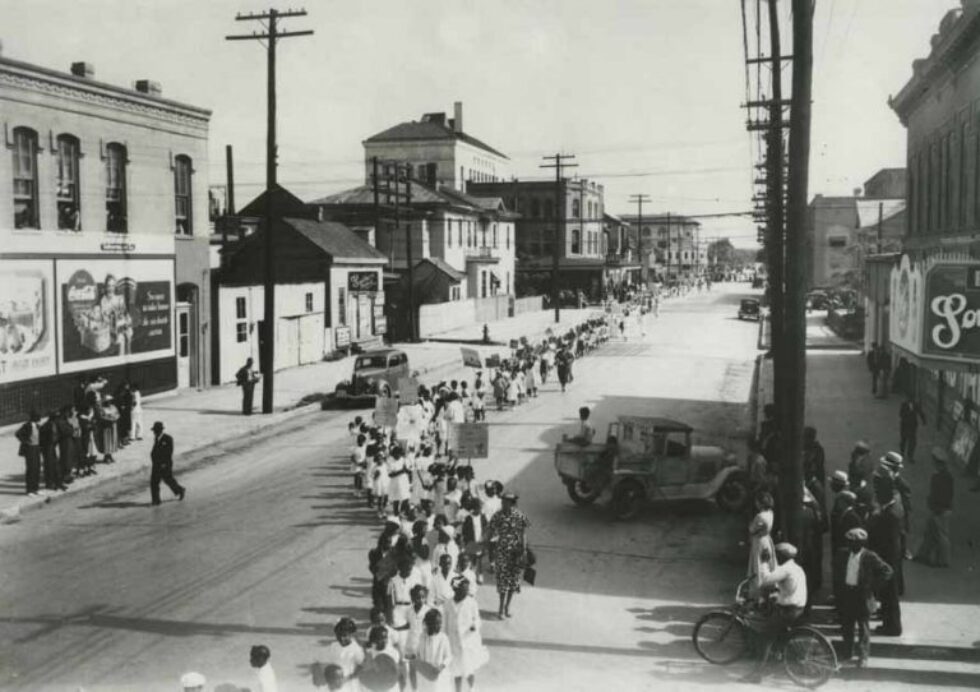
The East and West District Schools reorganized in the 1930s. The school on the eastern end of town became known as Booker T. Washington and was located at 27th and Avenue M. The West District School evolved into George W. Carver School along 35th and Avenue M 1/2.
Tommie Boudreaux shares her memories of school plays at Booker T. Washington Elementary.
Fay Williams recalls recreational activities offered at Booker T. Washington Elementary.

After Galveston’s schools were integrated, Booker T. Washington and George W. Carver were consolidated into a single campus at the Carver site. It was renamed in honor of Dr. Leon A. Morgan who served as principal of Central High School from 1941 – 1967. Morgan Elementary still operates on the site today.
Alice Gatson remembers walking to school and picking up classmates along the way.

Established in 1885, Central High School was the first high school for African Americans in the state of Texas. The school was initially housed in a rented frame building near the corner of Avenue L and 16th Street. In 1893, the well-known Galveston architect Nicholas Clayton designed an attractive two-story brick building with multiple classrooms on the 2600 block of Avenue M. The original structure was later demolished, but the 1924 annex still stands and today is home to the Old Central Cultural Center.
Listen to James Josey discuss how discipline was carried out by teachers at Central High School.
Cornelia Harris Banks offers her thoughts on how the Galveston School Board handled integration.
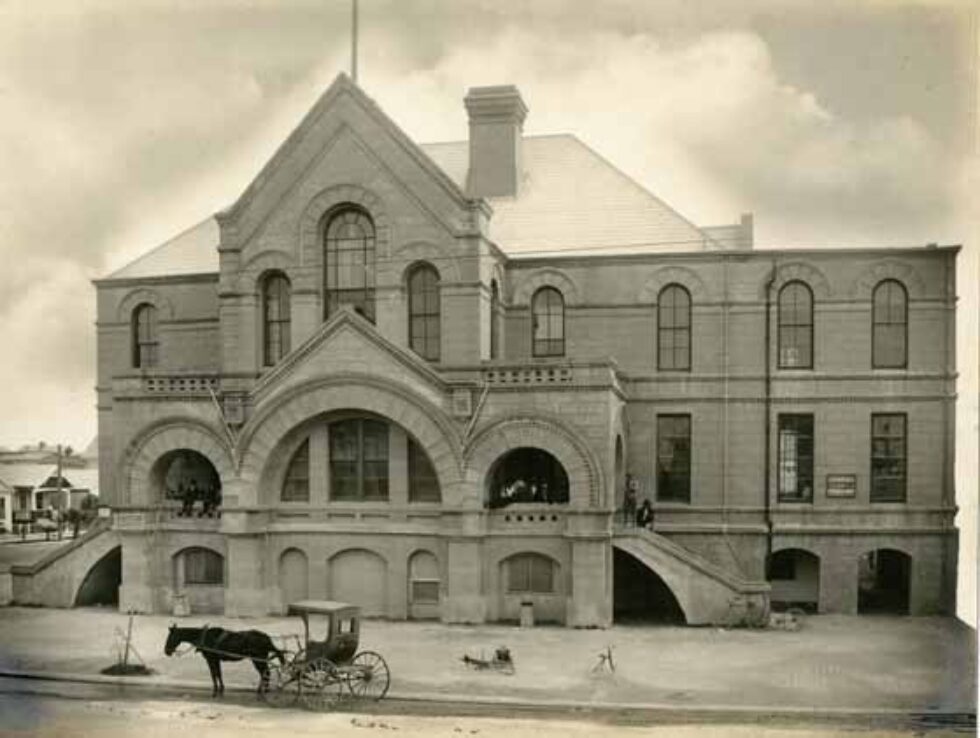
In addition to performing at football games, the Bearcat Band was often invited to participate in local parades and civic events. Many of Central High School’s band members went on to play music on a professional level as adults.
Listen to Izola Collins describe performances by the acclaimed Central High School Band.

While a junior at Central High School, Kelton Sams initiated the lunch counter sit-in movement in Galveston. These peaceful student demonstrations led to the successful integration of island lunch counters in 1961.
After graduation, Sams enrolled at Texas Southern University where he was elected student body president. He has remained active in religious, political, and economic affairs in the Houston area and nationally since leading the lunch counter sit-ins.
Hear Kelton Sams talk about the lunch counter sit-ins which he organized more than fifty years ago.

This image features a baseball team from Central High School. In 1962, the school won the state championship for baseball.
David O’Neal remembers the discrimination he faced after being recruited to play baseball in college.
Listen to team member Frederick Ferguson talk about winning the 1962 state championship in baseball.

During its 83-year history, Central High School was recognized for excellence in both academics and athletics, with many state championship titles awarded in sports. After a number of years without a state win, the 1964 Central High School football team successfully defeated Dallas Madison to become Texas State Champions. It was the last big win before Central High was closed after integration in 1968.
Hear Frederick Ferguson relive the emotional win at the 1964 Texas State Championship football game.
Bural Walker recalls the valuable advice given to him by Coach Ray Sheppard.

Shortly after the opening of the Rosenberg Library in 1904, a separate “Colored Branch” for African Americans was established. It is believed to be the first public library for blacks in the southern United States. The Colored Branch was housed in an annex to Central High School, the first African American high school in Texas.
Fay Williams remembers librarian Lillian Davis and her commitment to encouraging literacy.
Irenaeus Jordan shares her experiences with separate and unequal school facilities.
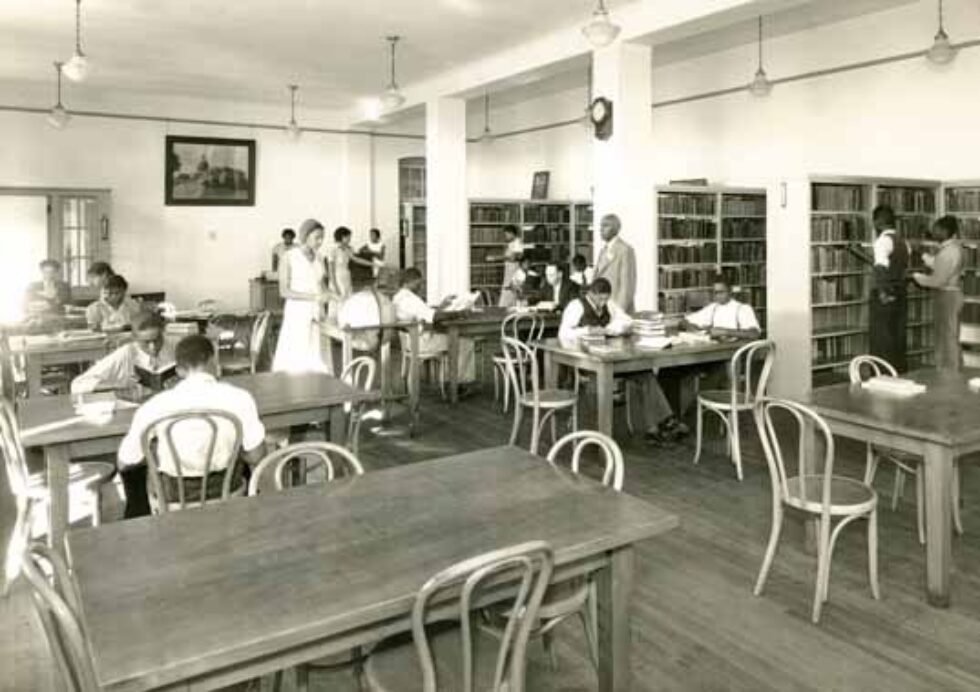
In 1840 — just one year after the City of Galveston was officially incorporated — members of the all-white First Baptist Church established a separate congregation for slaves. Later called the Colored Baptist Church, this congregation eventually erected its own building at Avenue L and 26th Street.
Roland Thomas talks about his grandfather who was a member of Avenue L Baptist Church during its time as a slave congregation.
Hear Frederick Ferguson’s memories of Sunday School with Sister Coleman at West Point Baptist Church.

Though Reedy Chapel A.M.E. had existed in Galveston since the 1840s, by the 1860s a second A.M.E. church was needed to accommodate the increasing number of African American residents who lived west of 25th Street. Shiloh A.M.E. Church was constructed at 1310 29th. Hurricanes in 1894 and 1900 destroyed earlier buildings, but the present structure dates to 1923.
David O’Neal remembers the importance of Easter speeches and other opportunities for public speaking encouraged by local churches.

After the Civil War, many African Americans in the port city of Galveston found work as longshoremen, loading and unloading cargo on ships. Bales of cotton were wound as tightly as possible with specialized screw jacks before being placed in the holds. Known as “cotton jammers” or “screwmen” these laborers created their own powerful union in 1879 after being denied admittance into the white union.
Known as the Cotton Jammers Association, the group established a park near 37th Street and Avenue S which provided a venue for special events and celebrations for the African American community.
Fay Williams describes the origins of the term “cotton jammer.”
Listen to Frederick Ferguson talk about working on the wharves to earn money during high school.

James Josey and Irenaeus Jordan discuss the segregated bus system in Galveston during the Jim Crow era.
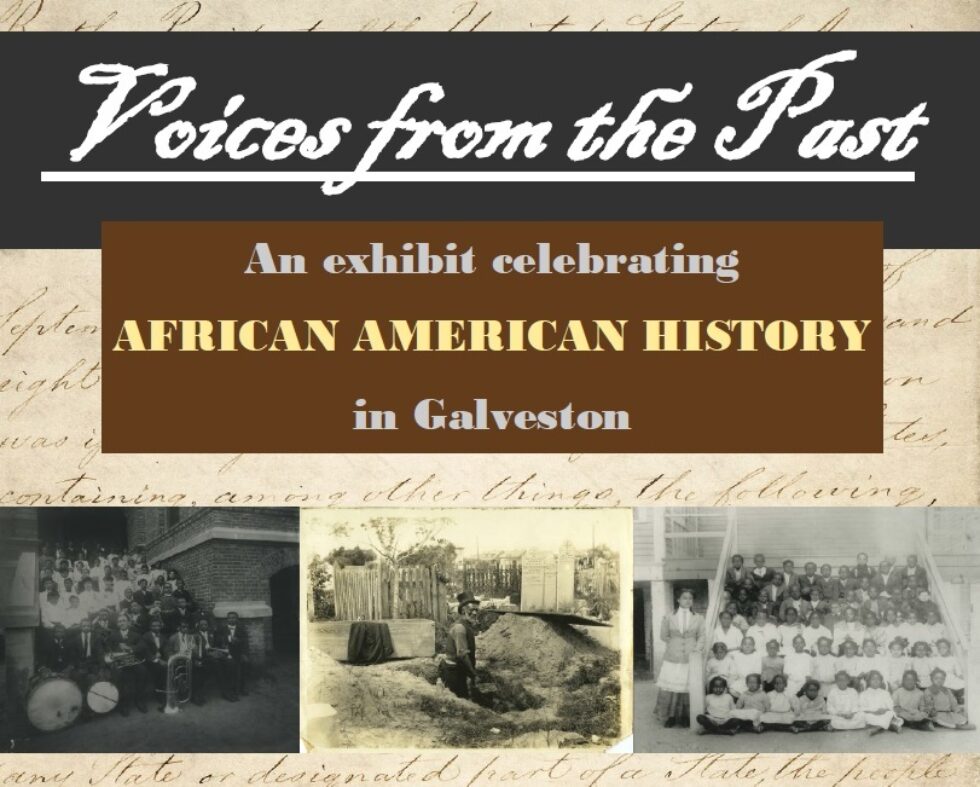
Before the 1960s, Galveston’s beachfront was segregated. Whites enjoyed swimming and beach recreation on the east end of the island, while African Americans did the same on the west end. There was, however, a one-block stretch of beach on the eastern side of Galveston which was open to black residents. Between 28th and 29th Street along Seawall Boulevard stood several popular black-owned businesses including Gus Allen’s Villa, the Jambalaya Restaurant, and the Manhattan Club.
James Josey talks about Galveston’s segregated beachfront and places where African American residents gathered to socialize on the waterfront.

Thomas Deboy Armstrong was born in Louisiana in 1907; the family later moved to Texas. Armstrong graduated from Prairie View College in 1929 and settled in Galveston with his wife, Marguerite, in 1938.
In addition to a drugstore, the Armstrongs owned the adjacent Kenyon Auto Supply.
Fay Williams and James Josey remember some of the well known black-owned businesses on the island, including their favorite eating establishments.

Hear Fay Williams and Irenaeus Jordan talk about forms of discrimination they encountered while growing up in Galveston during the 1950s.

This photo shows Gus Allen (far right) with the staff of Honey Brown’s Barbecue. The restaurant was located at 28th and Church, near several of Allen’s own businesses.
Nelson “Honey” Brown and his wife, Edna, operated the restaurant from the 1940s until his death in 1979. The well-known eatery was popular with both black and white customers.
David O’Neal describes the downtown block along Church and 27th Street where a group of African American entrepreneurs operated their businesses.

Tommie Boudreaux remembers a white bus driver who refused to make her and her young siblings sit at the back of the bus.
Bernard Curtis talks about the integration of Galveston’s municipal golf course.

Hear about an important life lesson David O’Neal learned from his father when he was a child.

Rosenberg Library proudly announced Voices from the Past: An Exhibit Celebrating African American History in Galveston which featured historic images from the library’s archival collection related to the African American history in Galveston.
Voices from the Past includes an assortment of late 19th and early 20th century photographs from the Galveston and Texas History Center at Rosenberg Library. On display will be images of schools, churches, businesses, and residents which collectively portray the island’s rich African American cultural heritage.
Rosenberg Library partnered with local residents to develop a unique interactive tour which allows visitors to watch and listen to personal stories which relate to the photos. Topics range from emotional anecdotes regarding discrimination and segregated facilities to more lighthearted tales of recreation and childhood adventures. Visitors can access video and audio content to enhance the experience using their own cell phone or smart phone.
Acknowledgments
Voices from the Past is a collaboration with Galveston Reads 2015. Rosenberg Library thanks the following organizations and individuals who contributed to the exhibit:
Old Central Cultural Center, Galveston Reads, Bernard W. Curtis, David H. O’Neal, Jr., Doug Matthews, Frederick Ferguson, Kelton D. Sams, Jr., Pete Henley, Cornelia Harris Banks, Alice Gatson, Roland P. Thomas, Tommie D. Boudreaux, Irenaeus Jordan, Bural R. Walker, Izola E.F. Collins, James E. Josey, Sr., and Fay H. Williams.
Voices from the Past includes photographs generously donated to Rosenberg Library by The Allen Family, Bert Armstead, Izola Collins, and Dr. L.A. Morgan.
